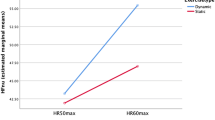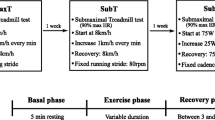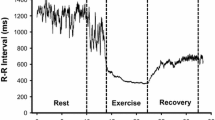Abstract
The long-term conditioning effects of physical training on cardiorespiratory interaction in 11 young healthy males were studied. Significant increases in maximum oxygen uptake (\(\dot VO_{2\max }\))(P < 0.05) and decreases in heart rate (P < 0.05) were achieved in all subjects following a 6-week training programme consisting of cycling for 25 min each day at a work level that increased heart rate to 85% of maximum. Heart rate variability, measured as the differences between the maximum and minimum R-R interval in a respiratory cycle, increased in nine of the subjects and decreased in two. The respiratory-cycle-related high-frequency peak in the power spectral plot of R-R variability also showed significant increases in the same nine subjects and decreases in two. The latter result was similar after normalisation of the data for changes in heart rate by calculating the common coefficient of variance (\(CCV = \frac{{HF}}{{R - R}}x 100\)), where HF is the high-frequency component of the power spectral plots, using a further measure of vagal tone it was shown that, for all subjects, the R-R interval change in response to isometric contractions of the arm flexors in one respiratory cycle were significantly greater after training. These data suggest that cardiac vagal tone is increased by aerobic training for all subjects and that this is accompanied by a respiratory sinus arrhythmia (RSA) in most, but may be associated with a decrease in RSA in subjects with a very low ( < 50 beats-min−1 heart rate.
Similar content being viewed by others
References
Aguirre A, Wodlicka GR, Maayan C, Shannon DC (1990) Interaction between respiratory and RR interval oscillations at low frequencies. J Anton Nerv Syst 29:241–146
Al-Ani M, Powell L, West J, Townend J, Coote JH (1995) Exercise and diving, two conflicting stimuli influencing cardiac vagal tone in man. J Physiol (Lond) 489:603–612
Astrand P, Rodahl K (1986) Textbook of work physiology. McGraw Hill, London
Barney JA, Ebert TJ, Groban L, Farrell PA, Hughes CV, Smith JJ (1988) Carotid baroreflex responsiveness in high-fit and sendentary yound men. J Appl Physiol 65:2190–2194
Burg JP (1975) Maximum entropy spectral analysis. PhD Thesis. Geophysics Department, Stanford University, USA
Butler PJ, Woakes AJ (1987) Heart rate in humans during underwater swimming with and without breath-hold. Respir Physiol 69:387–399
Clausen JP (1977) Effect of physical training on cardiovascular adjustments to exercise in man. Physiol Rev 57:799–815
De Meersman RE (1992) Respiratory sinus arrhythmia alteration following training in endurance athletes. Eur J Appl Physiol 64:434–436
Decety J, Jeannerod M, Durozard D, Baverel G (1993) Central activation of autonomic effectors during mental stimulation of motor actions in man. J Physiol (Lond) 461:549–563
Eckberg DL (1983) Human sinus arrhythmia as an index of vagal cardiac outflow. J Appl Physiol 54:961–966
Ekblom B, Kilblom A, Soltysia K (1973) Physical training, bradycardia and autonomic nervous system. Scand J Clin Lab Invest 32:251–256
Fiocchi R, Fagard R, Vanhees L, Grauwels R, Amery A (1985) Carotid baroreflex sensitivity and physical fitness in cycling tourists. Eur J Appl Physiol 54:461–465
Freyschuss U (1970) Cardiovascular adjustments to somato motor activation. Acta Physiol Scand Suppl 342:5–63
Frick MH, Elovainio RO, Somer T (1967) The mechanism of bradycardia evoked by physical training. Cardiologia 51:46–54
Hirsch JA, Bishop B (1981) Respiratory sinus arrhythmia in humans: how breathing pattern modulates heart rate. Am J Physiol 241:11620–11629
Gandevia SC, Killian K, McKenzie DK, Crawford M, Allen GM, Gorman RB, Hales JP (1993) Respiration sensations, cardiovascular control, kinaesthesia and transcranial stimulation during paralysis in humans. J Physiol (Lond) 470:85–107
Karemaker JM (1993) Analysis of blood pressure and heart rate variability: theoretical considerations and clinical applicability. In: Low PA (ed) Clinical autonomic disorders. Little Brown, London, pp 315–330
Katona PG, Jih F (1975) Respiratory sinus arrhythmia: noninvasive measure of parasympathetic cardiac control. J Appl Physiol 39:801–805
Katona PG, McLean M, Dighton DH, Guz A (1982) Sympathetic and parasympathetic cardiac control in athletes and non-athletes at rest. J Appl Physiol 52:1652–1657
Lewis S, Nylander E, Gad P, Areskog NH (1980) Nonautonomic component in bradycardia of endurance trained men at rest and during exercise. Acta Physiol Scand 109:297–305
Maciel BC, Gallo L, Neto JAM, Filho ECL, Filho JT, Manco JC (1985) Parasympathetic contribution to bradycardia induced by endurance training in man. Cardiovasc Res 19:642–648
Maciel BC, Gallo L Jr, Marin Neto JA, Martins LEB (1987) Autonomic nervous control of the heart rate during isometric exercise in normal man. Pflugërs Arch 408:173–177
McMahon SE, McWilliam PN (1992) Changes in RR interval at the start of muscle contraction in the decerebrate cat. J Physiol (Lond) 447:549–562
Raab W, Silva PP, Marchet H, Kimura E, Starcheska YK (1960) Cardiac adrenergic preponderance due to lack of physical exercise and its pathogenic implications. Am J Cardiol 5:300–320
Reiling MJ, Seals DR (1988) Respiratory sinus arrhythmia and carotid baroreflex control of heart rate in endurance athletes and untrained controls. Clin Physiol 8:511–519
Scheuer J, Tipton CM (1977) Cardiovascular adaptations to physical training. Annu Rev Physiol 39:221–251
Secher NH (1985) Heart rate at the onset of static exercise in man with partial neuromuscular blockade. J Physiol (Lond) 368:481–490
Somers VK, Conway J, Johnston J, Sleight P (1991) Effects of endurance training on baroreflex sensitivity and blood pressure in borderline hypertension. Lancet 337:1363–1368
Toska A, Eriksen M (1993) Respiratory-synchronous fluctuations in stroke volume, heart rate and arterial pressure in humans. J Physiol (Lond) 472:501–512
Weiling W, Borst C, Van Lieshout JJ, Sprangers RLH, Karemaker JM, Van Brederode JFM, Van Montfrans GA, Dunnind AJ (1985) Assessment of methods to estimate impairment of vagal and sympathetic innervation of the heart in diabetic autonomic neuropathy. Neth J Med 28:383–392
Zetterberg LH (1969) Estimation of parameters for a linear difference equation with application to EEG analysis. Math Biosci 5:227–275
Author information
Authors and Affiliations
Rights and permissions
About this article
Cite this article
Al-Ani, M., Munir, S.M., White, M. et al. Changes in R-R variability before and after endurance training measured by power spectral analysis and by the effect of isometric muscle contraction. Europ. J. Appl. Physiol. 74, 397–403 (1996). https://doi.org/10.1007/BF02337719
Received:
Issue Date:
DOI: https://doi.org/10.1007/BF02337719




